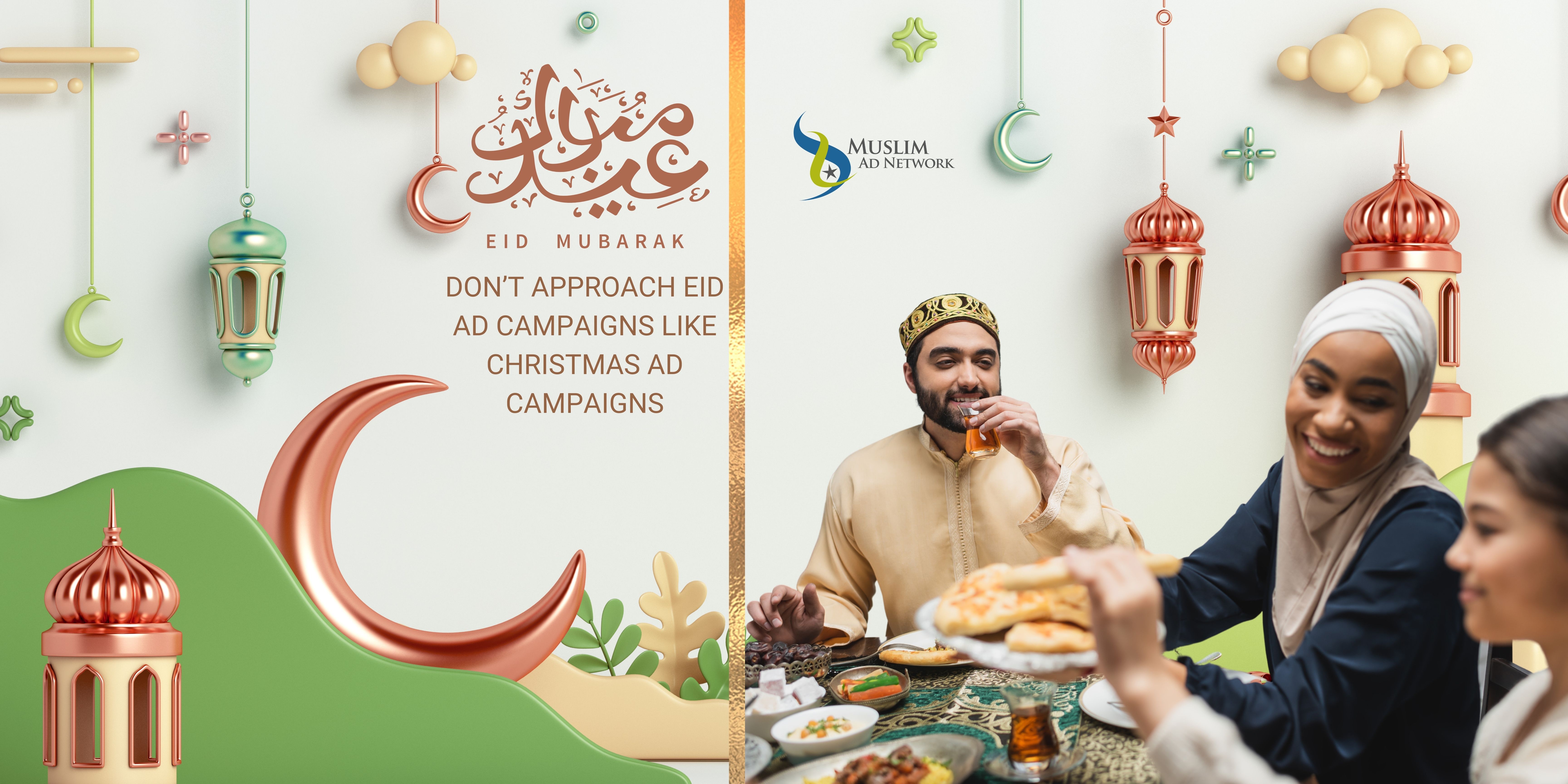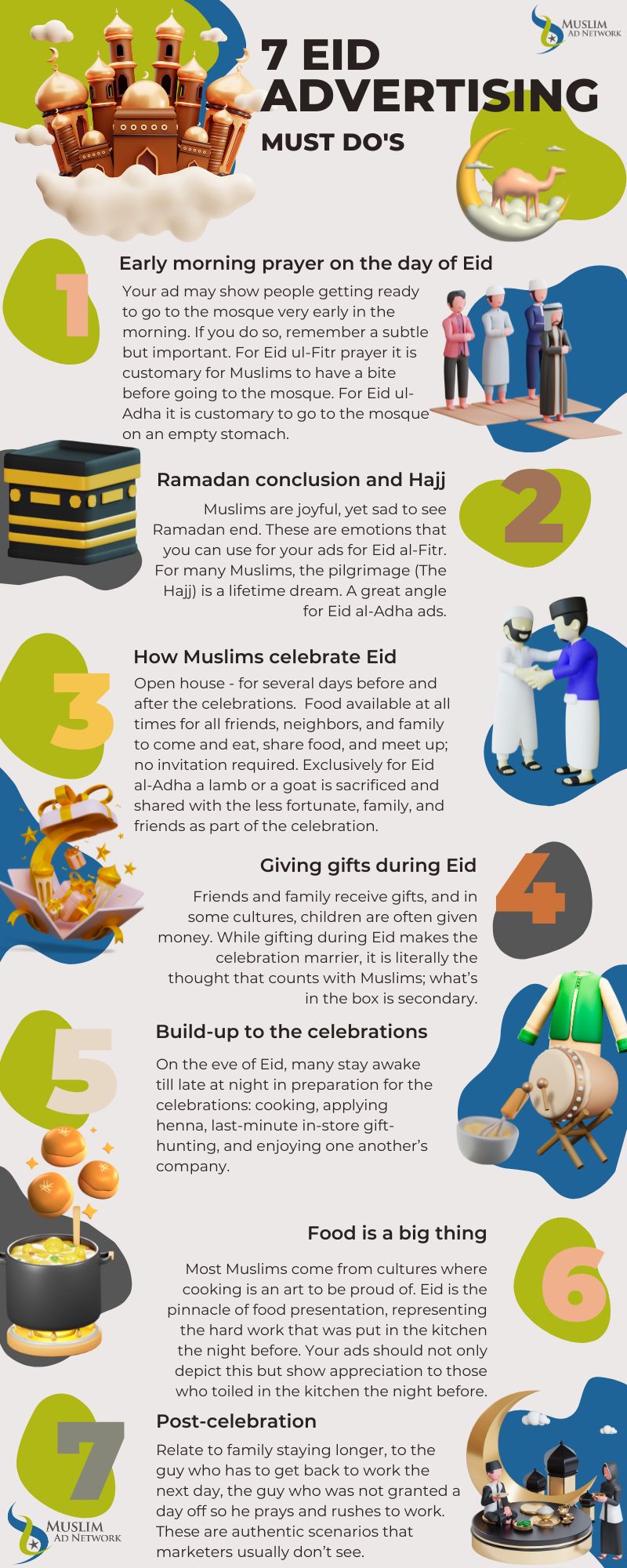
There are some common reasons for unsuccessful Eid campaigns. It’s important to understand your audience and tailor your messaging to appeal to them. Failing to do so can result in negative branding and backlash.
Approaching Eid ad campaigns like you would do so for Christmas ad campaigns or any other holiday-season ad campaign is probably one of the most common mistakes by brands and marketers alike. Let us look at some basics first before we dive into this subject.
Keep the Multicultural Aspect in Mind
One way to reach western Muslim audiences during Eid is through multicultural marketing and advertising. This can be achieved through leveraging technology and targeting specific communities in the United Kingdom, the United States, and other western countries with large Muslim populations.
Multicultural marketing is a strategy that aims to reach and engage with diverse cultural or ethnic groups. When implementing multicultural marketing, it’s important to understand that Muslims are not a homogenous group and have subcultures with different behaviors, customs, and values. To find what is common among Muslims, it’s important to focus on universal values such as respect, family, and community. This can help create a more inclusive and effective marketing approach.
Keep the Religious Aspect in Mind
As a marketer or advertiser, it is important to know that Eid is a religious holiday celebrated by Muslims worldwide. It is a time of reflection, gratitude, and community. Muslim consumers may display joy, gratitude, and generosity during Eid. It is important to be respectful and avoid behaviors that may be seen as offensive, such as any acts of disrespect towards religious practices or cultural traditions.
Buzzwords commonly used by Muslims during Eid include “Eid Mubarak” and “Allah hu Akbar.” There are two Eids celebrated by Muslims: Eid ul-Fitr, which marks the end of Ramadan, and Eid ul-Adha, which commemorates the sacrifice of Prophet Ibrahim (AS). Common behaviors among all Muslim subcultures during Eid include attending prayer services, exchanging gifts, and sharing meals with family and friends.
Approach Eid Differently From Christmas
Whatever you do, don’t take out your Christmas marketing and advertising campaign strategy from last year and copy-paste it into your Eid campaign just because they are both holidays based on religion.
Eid and Christmas are different holidays with unique cultural and religious significance. While Christmas is often associated with consumerism and commercialization, Eid is typically celebrated with a focus on family, community, and spiritual reflection. Additionally, Eid is primarily observed by Muslims, while Christmas is celebrated by Christians and non-Christians worldwide.
Here are some differences to consider so that you avoid the pitfall of using Christmas strategies for Eid marketing and advertising campaigns:
Prayers
Eid
Early morning on the day of Eid
Christmas
Midnight on Christmas eve
Action
Your ad may show people getting ready to go to the mosque very early in the morning. If you do so, remember a subtle but important issue:
- For Eid ul-Fitr prayer it is customary for Muslims to have a bite before going to the mosque.
- For Eid ul-Adha it is customary to go to the mosque on an empty stomach.
Make sure you depict the right behavior for the right Eid.
What the Day Represents
Eid
- Eid ul-Fitr: conclusion of Ramadan
- Eid ul-Adha: honors the willingness of Abraham (Prophet Ibrahim) to sacrifice his son Ishmael (Prophet Isma’il)
Christmas
The birth of the Messiah, Isa the son of Maryam
Action
- Muslims are joyful, yet sad to see Ramadan end. These are emotions that you can use for your ads for Eid ul-Fitr.
- For many Muslims, the pilgrimage (Hajj) is a lifetime dream that they want to achieve. It is a longing that creates amazing feelings. This is a great angle for a campaign for Eid ul-Adha.
Celebrations
Eid
Open house – for several days before and after the celebrations. Homes will have food available at all times for all friends, neighbors, and family to come and eat, share food, and meet up; no invitation is required. Exclusively for Eid ul-Adha a lamb or a goat is sacrificed and shared with the less fortunate, family, and friends as part of the celebration.
Christmas
On Christmas Day, most families have lunch or dinner with family and friends.
Action
Yes, the funny uncle that everyone likes can come at any time. Imagine as a kid just waiting for him to come through that door. Use your imagination to depict the open-door policy of Eid for your ads.
Giving Gifts
Eid
Friends and family receive gifts, and in some cultures, children are often given money.
Christmas
Gifts are exchanged between friends and family. For kids, they may have theirs placed under the Christmas tree.
Action
While gifting during Eid makes the celebration merrier, it is literally the thought that counts with Muslims; what’s in the box is secondary. Depict this in a way that highlights the spirit of gifting.
The Prophet (peace be upon him) said:
Give presents to one another for this would increase your mutual love.
Source: Sahih Muslim, Book 12: Gifts
The Build-up to the Celebrations
Eid
Muslims will have fasted up to thirty days in Ramadan before Eid ul-Fitr. Many also fast on the day before Eid ul-Adha, a day known as Arafa. However, on the eve of both eids, many stay awake till late at night in preparation for the celebrations: cooking, applying henna, last-minute in-store gift-hunting, and enjoying one another’s company.
Christmas
With office parties and get-togethers leading up to Christmas, Christians, and non-Christians celebrate and overindulge in food and drink.
Action
Remember that the build-up is spiritual in nature but there is also an element of preparation which includes some fun. Create a balance between the two in your Eid Ads.
Food
Eid
This is determined by the culture. Rice, meat, dates, fruit, and cookies are common staples. South Asian foods such as samosas, biriyani, and desserts like jalebi and gulab jamun have infiltrated many other cultures and are widely consumed during Eid, in Arab and African cultures. The Arab halwa is also quite common across cultures. Because so many people come and go throughout the day at different times, a buffet format is frequently used.
Christmas
While this varies by culture, most people in the West adhere to the Western traditional menu which includes cake, roast turkey, gravy, roast potatoes, roast vegetables, cranberry sauce, Christmas pudding, and so on.
Action
One word: close-ups! Most Muslims come from cultures where cooking is an art to be proud of. Eid is the pinnacle of food presentation, representing the hard work that was put in the kitchen the night before. Your ads should not only depict this but show appreciation to those who toiled in the kitchen the night before.
Post-celebration
Eid
In many cases families who visited stay for a few days if they have come from far. Many go to work in Western countries as Eid is not an official holiday. They have to ask for a day off.
Christmas
Christians and everyone else usually have the week off holidaying or relaxing at home. Schools and offices are closed and everyone is preparing for the new year celebrations.
Action
Let your ad speak to the feeling of family staying longer, to the guy who has to get back to work the next day, and the guy who was not granted a day off so he prays and rushes to work. These are very real and authentic scenarios that marketers usually don’t see but can be very powerful if depicted well.

Conclusion
Remember to also approach your campaign with a human touch, as authenticity can go a long way in building a positive relationship with your customers. To build relationships with Muslims, it’s important to engage with them throughout the year, not just during Ramadan or before Eid. Hiring Muslim experts can also help create more personalized and impactful campaigns for Eid.
Having gained further insights into the holidays and their differences, you know that Eid is an opportunity for your brand to engage Muslim consumers if done in the right way. It’s all about making culturally (and religiously) aware decisions that will ultimately yield success for your business.
